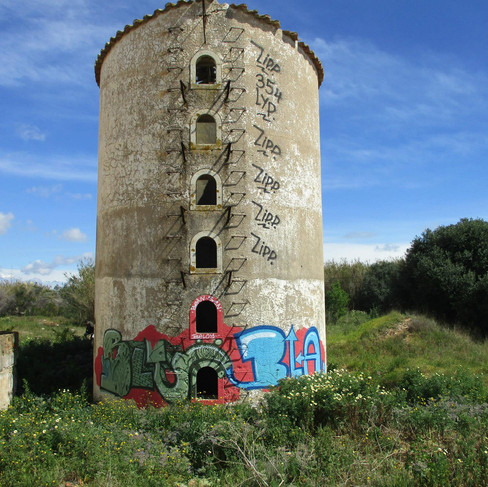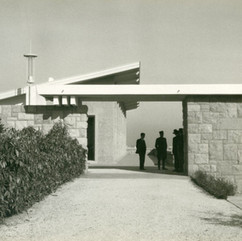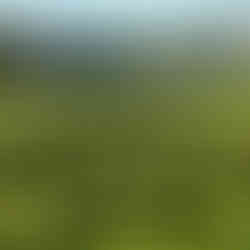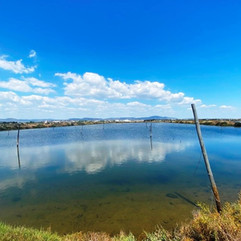The guardians of the Fialho family
The silos on the SEN site
A while ago I saw them on the Facebook site of urban artists SEN from Olhão. They are two silos that appear as a kind of guardians on the edge of the N125, before Faro goes changes into Olhão. The shape of the buildings in special - the oval outline and the rounded saddle roofs - intrigued me and therefore a good reason to do some research..
There is a Portuguese website called SIPA (Sistema de Informação para o Património Arquitetónico) where buildings from every city in Portugal that have a special meaning are inventoried with regard to their history or as heritage. I soon found them under silos in the heritage of Faro. They are described as: Agricultural architecture from the nineteenth century with clindrical shapes, a high rounded saddle roof and rounded openings in the front facade. The two silos appear to have belonged to a large estate: the Salgados. The Júdice Fialho family had them built on their estate at the end of the nineteenth century to store grains and cattle feed. However, the silos are not only listed in the SIPA system, but are also mentioned in the 1956-60 study carried out by the Portuguese Architects Association on "Popular Architecture" in Portugal.

The silos in the book about the research on “Popular Architecture” in Portugal.
The name of Júdice Fialho did ring several bells. The 'empire' of Júdice Fialho (from 1861 to 1948) included canning in Portimão as well as canning in the rest of the country. As a shipowner, he had his own fishing fleet and his own shipyard, as well as various other business interests in different sectors. In Faro, Júdice Fialho is known for the magnificent palaces that he, or his family, owned or had built there. Such as the Fialho Palace - in French eclectic/classicist style - designed by the famous architect Manuel Joaquim Norte Júnior (1878-1962). During construction, Júdice Fialho used the richest and noblest materials such as wood from Brazil and enormous quantities of marble. The palace was richly decorated and had a valuable art collection consisting of paintings, tapestries and tableware. It had a freight elevator and was the first one in the Algarve to have a passenger elevator.
Palacio Fialho (now part of Colégio do Alto) in Faro
Júdice Fialho was known for his good work as a benefactor in the reconstruction of the Lethes Theater in Faro and for his archaeological collections. In 1929, Júdice Fialho acquired the Quinta do Morgado de Quarteira with an area of no less than 1700 hectares (at that time the largest landed property in the Algarve). It was sold in 1964 by the Júdice Fialho family to Artur Cupertino de Miranda of the Banco Português do Atlântico. He founded the Lusotur company and, in the second half of the 1960s, developed the town and marina of Vilamoura on the land. In addition to a marina, the plan also included hotels, a casino, tennis courts, nightclubs, bars and restaurants, various shops and several golf courses.
Development Vilamoura
One of the architects of the development of Vilamoura was the well-known Portuguese architect Keil do Amaral. Keil de Amaral (1919-1975) who started his career as the architect of the Portugal pavilion at the 1937 World Exhibition in Paris is also the architect of the city parks Eduardo VII and Monsanto in Lisbon. He was married to the artist Maria Keil (born in Silves) who is best known for her tile designs for various metro stations in Lisbon. Keil do Amaral wrote a book about his architectural journey to the Netherlands, where he became acquainted with the work of architect Dudok in Hilversum and became a great fan and defender of his work in Portugal. For Vilamoura, which in the years has grown into the Saint-Tropez of Portugal, Keil do Amaral drew up the urban development plan and devised the typologies of the main buildings. He worked on plans for Pinha da Marina, Centro Commercial de Vilamoura and Aldeia da Mar and in the early 1970s designed the first (temporary) casino, a church and a shopping centre together with architect José Antunes da Silva.
Pavilion World Exhibition Paris 1937, Book about architecture in the Netherlands and pavilion and park Eduardo VI
Projects of Keil do Amaral in Vilamoura
Back to 'the guardians of the Fialho family', much more is needed of course than research on the internet or in books to get a good view of the background of these two silos. On the website of the estate - called Herdade dos Salgados do Fialho - to which the silos belong, it can be read that the estate was built at the end of the 19th century by Júdice Fialho and consists of approximately 140 ha, divided over agricultural areas and wetlands for fish farming. The main activity is breeding Limousine cattle. There is also an area for fish farming of sea bream (sparus aurata) and there is a tourist accommodation for lovers of peace and nature in combination with agricultural activities. You can go fishing and horse riding on the Fialho estate.
Herdade dos Salgados do Fialho
Time to have a physical exploration by bike from Olhão. You can do this via the Ecovia (cycling & walking route), but unfortunately, at the border with Faro you are directed back to the N125, because Faro has not yet done anything about the Ecovia on its territory. The Herdade dos Salgados do Fialho borders with the new water purification plant of Faro. On the road to it you have to turn left just before the purification plant to get to the estate. When the farm appears in the distance on a dirt road, I immediately see the large guard dog lying in the middle of the road. But it seems that not only I have seen him, he seems to have seen me too. In full speed he comes towards me with a frightening open mouth. As fast as my legs allow me, I turn my bike and pedal as fast as I can in the direction I came from. I see the gap getting smaller between us...but then fortunately he gives up. Completely out of breath I arrive back at the water purification plant. I decide that it is better for me to continue my research about the Fialho estate on the internet.
































































Comments